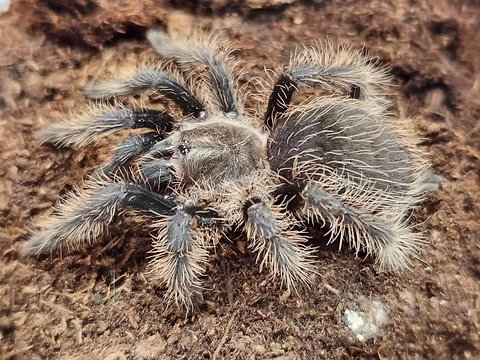The curly hair tarantula, also known by its scientific name Tliltocatl albopilosus, is a species of tarantula that has captured the fascination of arachnid enthusiasts and pet owners alike. With its striking appearance and unique behavior, this tarantula is a popular choice among those looking to keep tarantulas as pets.
However, like all exotic pets, they require a specific environment and care to thrive. In this article, we will explore the curly hair tarantula in depth, covering its natural habitat, physical characteristics, behavior, care requirements, and much more.
Table of Contents
What Is a Curly Hair Tarantula?
The curly hair tarantula is a species of tarantula native to Central America, specifically the rainforests of Honduras and Nicaragua. This species is known for its distinctive appearance, which features soft, curly hair on its body and legs. These hairs, scientifically known as setae, are where the tarantula gets its name from and are one of the most striking aspects of its physical appearance.
Curly hair tarantulas are a part of the Theraphosidae family, which is commonly referred to as the tarantula family. This group includes some of the largest and most well-known species of spiders in the world. Although they are not as large as some of their relatives, such as the Goliath birdeater, curly hair tarantulas can still reach impressive sizes, with a leg span of up to 5 inches (12.7 cm).
Physical Characteristics of the Curly Hair Tarantula
The curly hair tarantula is easily recognizable due to its distinctive, soft, and curly hairs that cover much of its body, including its legs, abdomen, and carapace. These curly hairs are not just for show; they play an important role in the tarantula’s defense mechanisms.
In the wild, the curly hair tarantula’s curly setae are used to defend itself against predators. When threatened, the tarantula will use its back legs to rub the setae against its body, releasing tiny, irritating hairs into the air. These hairs are capable of causing mild irritation to the skin and eyes of potential predators, making the tarantula a less appealing target.
The color of the curly hair tarantula varies, but it is typically brown or black with a slight sheen. The hairs on its body can range from golden to reddish-brown, further adding to its distinct look. Male curly hair tarantulas are generally smaller than females and have a more slender body structure.
Natural Habitat and Distribution
Curly hair tarantulas are native to the rainforests of Central America, primarily found in countries such as Honduras, Nicaragua, and Costa Rica. These spiders thrive in warm, humid environments with plenty of shelter, such as the dense underbrush and forest floors of tropical rainforests.
In their natural habitat, curly hair tarantulas spend most of their time on the ground or in burrows, which they dig themselves. The burrows provide protection from predators and create a stable microenvironment where the tarantula can regulate its temperature and humidity. These spiders are opportunistic hunters, feeding primarily on insects, small reptiles, and even amphibians that venture too close to their burrows.
Behavior and Temperament
Curly hair tarantulas are generally known for being docile and non-aggressive, making them a popular choice for pet owners who are new to keeping tarantulas. They are typically more reserved than other species, preferring to stay hidden in their burrows for the majority of the day. However, when they are active, they can display fascinating behavior, such as hunting for food or exploring their enclosure.
While they are not aggressive toward humans, curly hair tarantulas can become defensive if they feel threatened. When they sense danger, they will typically retreat into their burrow or other hiding spots. If cornered, they may flick hairs from their abdomen as a form of defense. These hairs are irritating to the skin and eyes, so it is essential to handle them with care, if at all.
In general, curly hair tarantulas are not known for being particularly fast or erratic, which makes them a bit easier to manage compared to more high-strung species like the pinktoe tarantula. However, they still require a level of respect and care when interacting with them.
Care Requirements for a Curly Hair Tarantula
Owning a curly hair tarantula as a pet is a rewarding experience, but it does require knowledge and commitment. Below, we will cover the essential care requirements for maintaining a healthy and happy curly hair tarantula.
Enclosure
The size of the enclosure should be appropriate for the size of the tarantula, with a minimum of a 10-gallon tank being suitable for most adult curly hair tarantulas. It is essential to ensure that the enclosure is well-ventilated and secure, as these spiders can climb and escape from poorly sealed tanks.
Curly hair tarantulas enjoy burrowing, so it is important to provide them with a substrate that is deep enough for them to dig. A mixture of peat moss, coconut fiber, and soil is an ideal substrate. This material will allow the tarantula to create its own burrow, which is crucial for its well-being.
Temperature and Humidity
Curly hair tarantulas thrive in temperatures ranging from 75°F to 85°F (24°C to 29°C). It is essential to maintain a stable temperature within this range to keep the tarantula comfortable. A heat mat or ceramic heater can help achieve the desired temperature, but be sure to avoid overheating the enclosure.
Humidity levels should be kept between 60% and 80%. This can be maintained by regularly misting the enclosure with water, but be careful not to make the substrate too damp, as this can lead to mold growth and health issues for the spider. A hygrometer can be used to monitor the humidity levels in the enclosure.
Feeding
Curly hair tarantulas are carnivorous and primarily feed on insects, such as crickets, mealworms, and roaches. Juvenile tarantulas should be fed smaller insects, while adult tarantulas can consume larger prey items. It is important to provide food items that are appropriately sized for the tarantula’s current size, as feeding them prey that is too large can lead to health problems.
Tarantulas typically eat once or twice a week, although some may go longer without food, particularly during molting periods. It is important to remove any uneaten food from the enclosure to prevent it from decaying and causing bacterial growth.
Molting
Like all spiders, curly hair tarantulas molt, or shed their exoskeleton, as they grow. This process is essential for their growth, but it can also be a vulnerable time for the spider. During molting, the tarantula may not eat, and it should be left undisturbed in its burrow. The old exoskeleton is typically consumed after the molt to reclaim essential nutrients.
Handling
While curly hair tarantulas are known for their relatively calm temperament, it is important to handle them with care. They are best observed rather than handled frequently. If handling is necessary, be gentle and use a soft brush or hand to encourage the tarantula to climb onto your palm. Avoid sudden movements or drops, as these can cause stress or injury to the tarantula.
Conclusion
The curly hair tarantula is a fascinating and relatively low-maintenance species that makes for a wonderful pet, especially for beginners. With its unique appearance and docile nature, it is easy to see why this tarantula is so beloved by arachnid enthusiasts. By providing the proper environment, diet, and care, you can ensure that your curly hair tarantula remains healthy and happy for many years. Whether you are a seasoned tarantula owner or a newcomer to the world of exotic pets, the curly hair tarantula is a species that offers both beauty and intrigue in equal measure.





